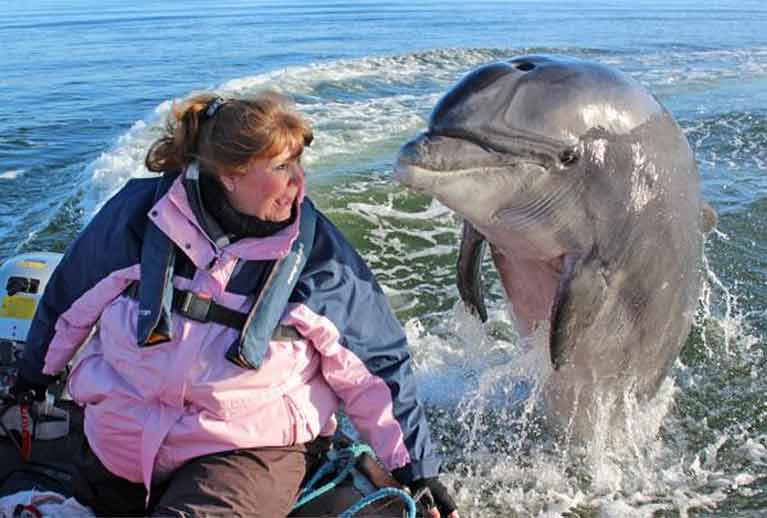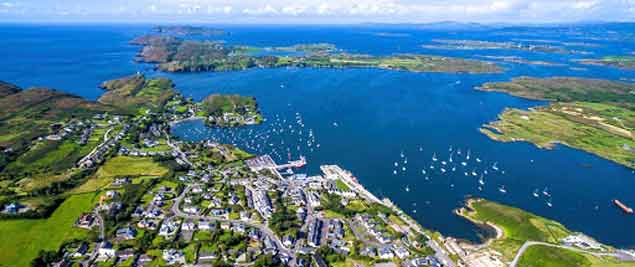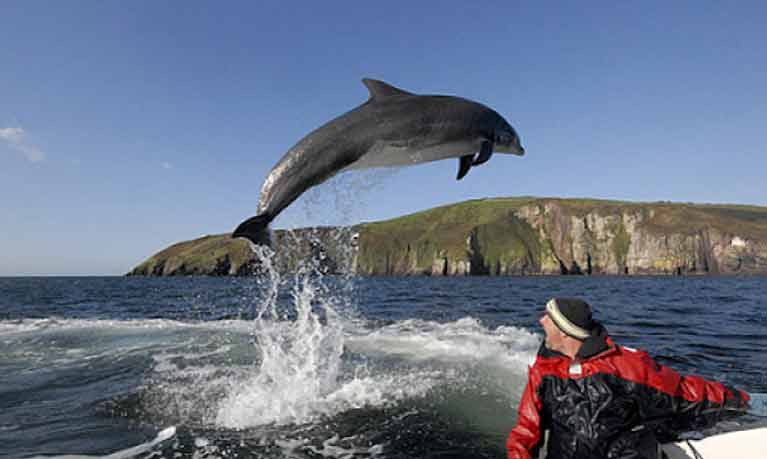There’s concern in West Kerry and worldwide among his fans and friends that Fungie the Dingle Dolphin is becoming depressed. He is being made gloomy by the lack of company and an audience for his usual summer season starring role, which would be playing to empty houses were he to put it on under the current Lockdown. Thus the word is that Dingle is organising a rota of boats to keep him company from time to time, but whether that will be remotely as good as the usual capacity crowd he gets in high summer remains to be seen.
Whale and dolphin specialists may sniffily tell us that it’s completely unnatural and maybe unhealthy for a lone bottlenose dolphin like Fungie to develop such a special relationship with a waterborne enraptured audiences of adoring fans. But if you’ve ever been in the midst of the milling fleet of boats as it wheels frenetically around Fungie as he goes through his many routines, you’ll realise that here is one very intelligent rockstar putting on a life-enhancing performance, and the fact that he has been joyously doing it since 1983 suggests that ill-health – whether physical or mental – had not been on the agenda until the current freakish situation.
In terms of rockstar/audience interaction, it certainly beats the experience being at Electric Picnic or Slane Castle on a damp midge-ridden evening every time. Our own best experience of it came after the Dun Laoghaire to Dingle race way back in 1995, when we joined the gathering fleet in the afternoon sunshine out in the harbour mouth, and suddenly he was among us. Fungie was leaping and pirouetting with such style and speed and enthusiasm that we’re convinced he went straight over our 35-footer between the mast and the backstay, because we certainly were very close indeed to the godlike presence.
 Well hello there…….close encounters with Fungie are never forgotten. Photo Dingle Dolphin
Well hello there…….close encounters with Fungie are never forgotten. Photo Dingle Dolphin
In the heightened mood, people become semi-demented, and one of our crew – he had better remain nameless – jumped in with the group already in the water trying to share the Fuungie experience to the uttermost. Some greater power seems to protect it all, because so far as is known, none of the head-cases who jump in has yet been struck by the flailing propellors of the heaving fleet.
So if there is one special early exemption from lockdown, it should be made for the Fungie experience in Dingle. He has taught us a lot, so much so that the very idea of eating whalemeat now seems like cannibalism, while it has been shown that the bonds that form from special relationships between dolphins and humans are not to be trifled with.
Twenty years or so ago, a “scientific” international research group formed an intimate bond with a dolphin, and when the experiment was over they simply went away and left him on his own in the sea. Becoming terminally depressed after the ending of the fun they’d had, he took his own life by descending to the seabed and not coming up for air.
That now seems an absolute disgrace caused by contemptible thoughtlessness, and the fact that we see it as such is heightened by our awareness of Fungie. This responsiveness to the sensitivities and fascination of special sea creatures is relatively new, for it’s now generally forgotten that very many years ago, Baltimore in West Cork was home to a semi-resident dolphin or pilot whale known as Albert.
This would have been in the 1920s to 1940s period, and Albert aroused mixed feelings. He would escort boats in and out through the harbour mouth, and when a visiting cruising boat had anchored off the village, he would occasionally rub up against the hull, supposedly to clear himself of sea lice, though his intentions were equally likely to have been amorous.
 High summer in Baltimore, West Cork. Nearly a hundred years ago, Baltimore’s resident dolphin or pilot whale - known as Albert - was rumoured to have moved anchored cruising boats from their carefully selected location off the village (foreground) all the way across the harbour to Sherkin Island during the night. Photo: Tom Vaughan
High summer in Baltimore, West Cork. Nearly a hundred years ago, Baltimore’s resident dolphin or pilot whale - known as Albert - was rumoured to have moved anchored cruising boats from their carefully selected location off the village (foreground) all the way across the harbour to Sherkin Island during the night. Photo: Tom Vaughan
Another of his tricks was to trip the anchor of carefully-anchored boats. Nowadays when it only needs a quick jab of astern with the auxiliary engine to dig the anchor in again, that wouldn’t be too much of a hassle. But in the old days when many craft were engine-less, it was a real pain to have to stick up some sail to make some way astern.
However, that was as nothing compared to the experience of at least two visiting crews, who went to sleep with their boats anchored serenely close in off Baltimore and woke in the morning to find themselves anchored over at Sherkin. Albert had taken it upon himself to move them quietly across Baltimore Harbour.
Nowadays people would be queuing up and paying good money for the extraordinary experience of having their boat moved almost a mile during the night by a friendly hyper-clever big dolphin. But back in the ancient times, visitors to Baltimore were earnestly warned of the hazards posed by Albert, he was looked on as very much of a mixed blessing, and most certainly not as a very special visitor attraction.































































